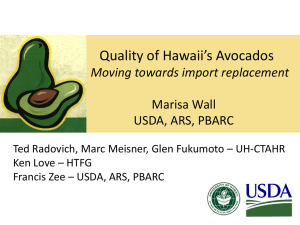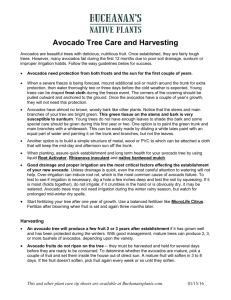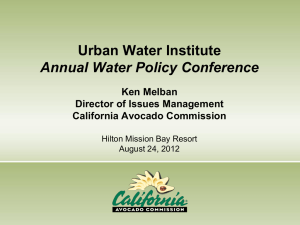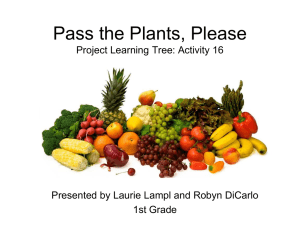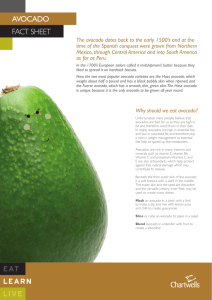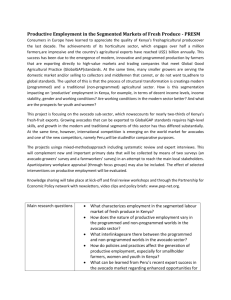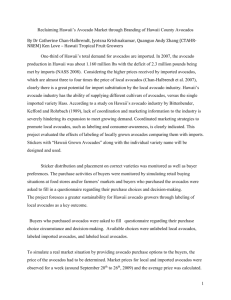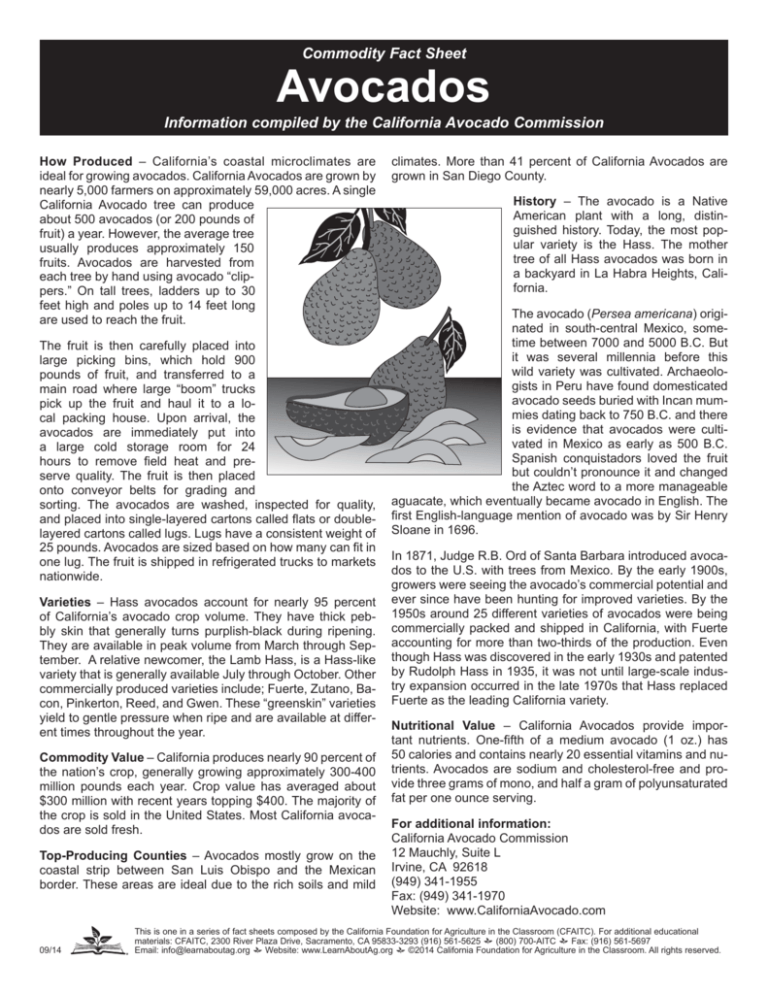
Commodity Fact Sheet
Avocados
Information compiled by the California Avocado Commission
How Produced – California’s coastal microclimates are
ideal for growing avocados. California Avocados are grown by
nearly 5,000 farmers on approximately 59,000 acres. A single
California Avocado tree can produce
about 500 avocados (or 200 pounds of
fruit) a year. However, the average tree
usually produces approximately 150
fruits. Avocados are harvested from
each tree by hand using avocado “clippers.” On tall trees, ladders up to 30
feet high and poles up to 14 feet long
are used to reach the fruit.
The fruit is then carefully placed into
large picking bins, which hold 900
pounds of fruit, and transferred to a
main road where large “boom” trucks
pick up the fruit and haul it to a local packing house. Upon arrival, the
avocados are immediately put into
a large cold storage room for 24
hours to remove field heat and preserve quality. The fruit is then placed
onto conveyor belts for grading and
sorting. The avocados are washed, inspected for quality,
and placed into single-layered cartons called flats or doublelayered cartons called lugs. Lugs have a consistent weight of
25 pounds. Avocados are sized based on how many can fit in
one lug. The fruit is shipped in refrigerated trucks to markets
nationwide.
Varieties – Hass avocados account for nearly 95 percent
of California’s avocado crop volume. They have thick pebbly skin that generally turns purplish-black during ripening.
They are available in peak volume from March through September. A relative newcomer, the Lamb Hass, is a Hass-like
variety that is generally available July through October. Other
commercially produced varieties include; Fuerte, Zutano, Bacon, Pinkerton, Reed, and Gwen. These “greenskin” varieties
yield to gentle pressure when ripe and are available at different times throughout the year.
Commodity Value – California produces nearly 90 percent of
the nation’s crop, generally growing approximately 300-400
million pounds each year. Crop value has averaged about
$300 million with recent years topping $400. The majority of
the crop is sold in the United States. Most California avocados are sold fresh.
Top-Producing Counties – Avocados mostly grow on the
coastal strip between San Luis Obispo and the Mexican
border. These areas are ideal due to the rich soils and mild
09/14
climates. More than 41 percent of California Avocados are
grown in San Diego County.
History – The avocado is a Native
American plant with a long, distinguished history. Today, the most popular variety is the Hass. The mother
tree of all Hass avocados was born in
a backyard in La Habra Heights, California.
The avocado (Persea americana) originated in south-central Mexico, sometime between 7000 and 5000 B.C. But
it was several millennia before this
wild variety was cultivated. Archaeologists in Peru have found domesticated
avocado seeds buried with Incan mummies dating back to 750 B.C. and there
is evidence that avocados were cultivated in Mexico as early as 500 B.C.
Spanish conquistadors loved the fruit
but couldn’t pronounce it and changed
the Aztec word to a more manageable
aguacate, which eventually became avocado in English. The
first English-language mention of avocado was by Sir Henry
Sloane in 1696.
In 1871, Judge R.B. Ord of Santa Barbara introduced avocados to the U.S. with trees from Mexico. By the early 1900s,
growers were seeing the avocado’s commercial potential and
ever since have been hunting for improved varieties. By the
1950s around 25 different varieties of avocados were being
commercially packed and shipped in California, with Fuerte
accounting for more than two-thirds of the production. Even
though Hass was discovered in the early 1930s and patented
by Rudolph Hass in 1935, it was not until large-scale industry expansion occurred in the late 1970s that Hass replaced
Fuerte as the leading California variety.
Nutritional Value – California Avocados provide important nutrients. One-fifth of a medium avocado (1 oz.) has
50 calories and contains nearly 20 essential vitamins and nutrients. Avocados are sodium and cholesterol-free and provide three grams of mono, and half a gram of polyunsaturated
fat per one ounce serving.
For additional information:
California Avocado Commission
12 Mauchly, Suite L
Irvine, CA 92618
(949) 341-1955
Fax: (949) 341-1970
Website: www.CaliforniaAvocado.com
This is one in a series of fact sheets composed by the California Foundation for Agriculture in the Classroom (CFAITC). For additional educational
materials: CFAITC, 2300 River Plaza Drive, Sacramento, CA 95833-3293 (916) 561-5625
(800) 700-AITC
Fax: (916) 561-5697
Email: info@learnaboutag.org
Website: www.LearnAboutAg.org
©2014 California Foundation for Agriculture in the Classroom. All rights reserved.
Avocado Activity Sheet
Around the World with Avocados
French fill halves with
shrimp and vinaigrette
dressing and eat them
as appetizers.
Americans use avocados
in salads, sandwiches
and burgers, and blend
them to create a
dip called guacomole.
Koreans mix them with
milk to use for facials or
body massages.
Cubans fill them with diced
vegetable salad.
Jamaicans flavor
them with lime
juice and Scotch
bonnet chiles to
make cold
avocado soup.
Mexicans add them to soft tacos
and call them “butterfruit” because
they are used like butter.
Japanese eat them in sushi rolls.
Taiwanese eat them with milk
and sugar.
Filipinos puree them with
sugar and milk to make a
dessert drink.
Nicaraguans stuff them with cheese,
cover them with batter and bake them.
Colombians and Ecuadorians
slice them into soups.
Indonesians mix them
with milk and coffee to
make a cold drink.
Chileans top hot dogs with them.
Brazilians add avocados
to ice cream.
Lesson Ideas
• Use craft materials to create individual packaging for safe
avocado transport. Test your invention by transporting your
avocado (via backpack) for several days. Compare your
results with others.
• Research which beauty products contain avocados and
develop an infomercial to promote an avocado-based product.
• On a California county map, shade in the counties which produce avocados.
• Make a picture book illustrating the harvesting of avocados.
• Cut open an avocado seed. Identify the embryo, cotyledons
and seed coat. Draw a cross-sectional view.
• Record and graph the weekly/monthly prices of avocados.
• Sprout an avocado plant from a seed.
• Examine various avocado skins using a hand lens or
microscope.
• Cut an avocado in half and remove the fruit and seed. Weigh
the skin, meat and seed in grams. What percent of the
avocado is edible?
• If a lug of size 48 avocados weighs 25 pounds, how much
does one average avocado of this size weigh? Convert to
ounces.
Fantastic Facts
1.
2.
3.
4.
5.
6.
7.
8.
Are avocados a fruit or a vegetable?
Which variety of avocado accounts for 95 percent of
California’s crop?
What percentage of the nation’s avocado crop does California
produce?
Which California county produces more avocados than any
other county?
Name one variety of avocado that has a green skin.
How are avocados harvested?
Are avocados sodium and cholesterol free?
How did the Hass avocado get its name?
1) Fruit 2) Hass 3) Approximately 90 percent 4) San Diego County
5) Fuerte, Zutano, Bacon, Pinkerton, Reed or Gwen 6) By hand using
special shears called clippers 7) Yes 8) It was discovered by Rudolf
Hass
Lesson Plan: Ripening an Avocado
Introduction: Avocados are increasingly shipped ripe and readyto-eat to retailers and foodservice operators. Some are shipped
“firm” and arrive at the point-of-purchase unripened. This experiment illustrates ways to speed the ripening process of avocados.
Ethylene is a natural hormone emitted from fruit such as avocados,
bananas and apples that causes the unripe fruit to ripen.
2.
Divide the students into groups and have them design an
experiment that would expedite the ripening process of
avocados. Show them various supplies such as bananas,
apples, paper bags, plastic bags and other items you have
available.
3.
Have each group obtain your approval of their experimental
design, conduct the experiment and complete a formal
laboratory report.
4.
At the completion of all of the experiments, have the students
share their results with the class. This can be done while the
class eats an avocado snack.
5.
Discuss the various methods that are used to commercially
ripen fruit such as avocados.
Materials: At least two avocados per group, bananas, apples,
paper bags, plastic bags and other supplies determined by the
students, knife.
Procedure:
1. Explain to the students why many fruits, including avocados,
are shipped unripe.
09/14
This is one in a series of fact sheets composed by the California Foundation for Agriculture in the Classroom (CFAITC). For additional educational
materials: CFAITC, 2300 River Plaza Drive, Sacramento, CA 95833-3293 (916) 561-5625
(800) 700-AITC
Fax: (916) 561-5697
Email: info@learnaboutag.org
Website: www.LearnAboutAg.org
©2014 California Foundation for Agriculture in the Classroom. All rights reserved.

